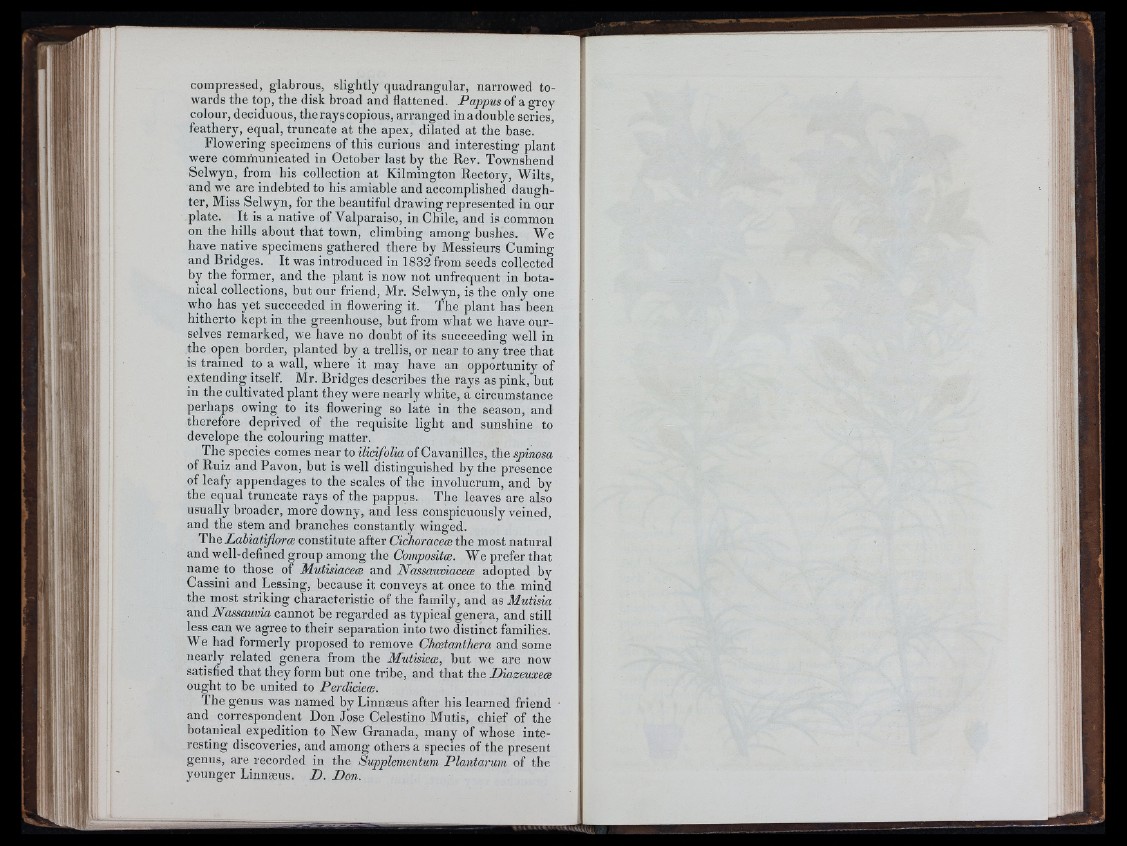
■t'®
îf]
compressed, glabrous, sliglitly quadrangular, narrowed towards
the top, the disk broad and flattened. Pappus of a grey
colour, deciduous, the rays copious, arranged inadouble series,
feathery, equal, truncate at the apex, dilated at the base.
Flowering specimens of this curious and interesting plant
were communicated in October last by the Rev. Townshend
Selwyn, from his collection at Kilmington Rectory, Wilts,
and we are indebted to his amiable and accomplished daughter,
Miss Selwyn, for the beautiful drawing represented in our
plate. It is a native of Valparaiso, in Chile, and is common
on the hills about that town, climbing among hushes. We
have native specimens gathered there by Messieurs Cuming
and Bridges. It was introduced in 1832 from seeds collected
by the former, and the plant is now not unfrequent in botanical
collections, but our friend, Mr. Selwyn, is the only one
who has yet succeeded in flowering it. The plant has* been
hitherto kept in the greenhouse, but from what we have ourselves
remarked, we have no doubt of its succeeding well in
the open border, planted by a trellis, or near to any tree that
is trained to a wall, where it may have an opportunity of
extending itself. Mr. Bridges describes the rays as pink, but
in the cultivated plant they were nearly white, a circumstance
perhaps owing to its flowering so late in the season, and
therefore deprived of the requisite light and sunshine to
develope the colouring matter.
The species comes near to iliáfolia of Cavanilles, the spinosa
of Ruiz and Pavon, but is well distinguished by the presence
of leafy appendages to the scales of the involucrum, and by
the equal truncate rays of the pappus. The leaves are also
usually broader, more downy, and less conspicuously veined,
and the stem and branches constantly winged.
The Labiatifloræ constitute after Cichoraceoe the most natural
and well-defined group among the Compositoe. We prefer that
name to those of Mutisiaceæ and Nassaumaceæ adopted by
Cassini and Lessing, because it conveys at once to the mind
the most striking characteristic of the family, and as Mutisia
and Nassauma cannot be regarded as typical genera, and still
less can we agree to their separation into two distinct families.
We had formerly proposed to remove Choetanthera and some
nearly related genera from the Mutisieæ, hut we are now
satisfied that they form but one tribe, and that the Diazeuxeoe
ought to be united to Perdicieæ.
The genus was named by Linnæus after his learned friend
and correspondent Don Jose Celestino Mutis, chief of the
botanical expedition to New Granada, many of whose interesting
discoveries, and among others a species of the present
genus, are recorded in the Supplementum Plantarum of the
younger Linnæus. D. Don.
IP'
UfiJ
111
■ilïîii
'I'pfl
îi'il
. T<i:iii| |I